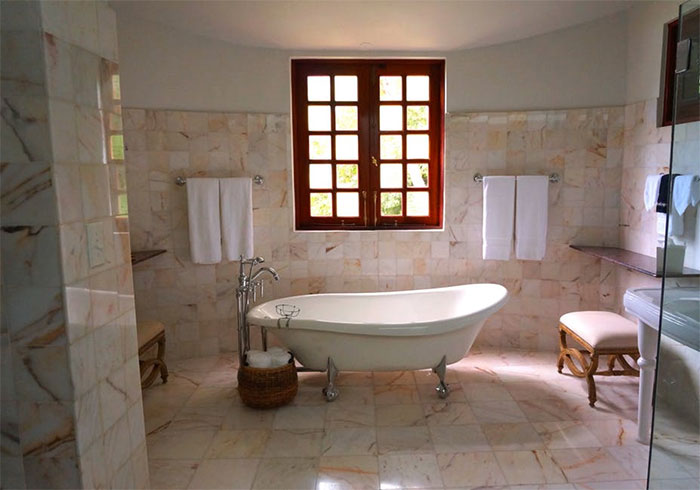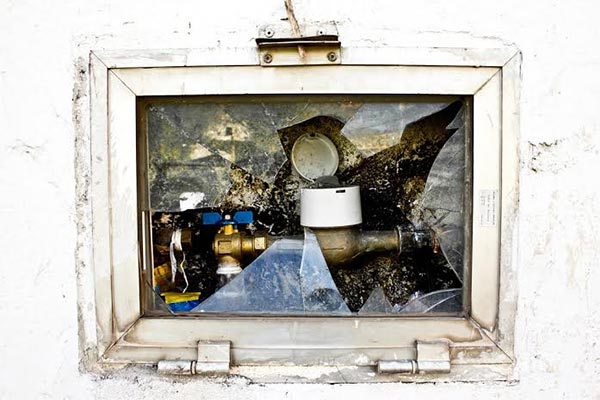Some people can’t shower in peace unless their bathroom is spotless, while others prefer to scrub the tiles immediately after they shower. Your bathroom keeps you looking clean and smelling great, but between steam, soap suds, and underwear, it can end up being the dirtiest room in your home. This is especially trying for your guest bathroom.
Fortunately, there are lots of easy ways to keep your sinks and tiles clean without too much drama, distress, or disinfectant bleach. You can find this advice in the least expected places – like the housekeeper’s lounge at big hotels. You may not give the cleaning staff much thought, but they clean hundreds of rooms every day, so they know their stuff.

Table of Contents
Do a Little Cleaning Every Day
That’s actually the first secret. Instead of waiting for your tile grout to get so murky that it seems to be moving, try cleaning your bathroom every day. Build a habit of quick spot cleaning. After your shower, while the bathroom is still steamed up, target key areas. Your cleaning should be light, so that your sweat doesn’t negate the bath you just had.
Take a few minutes to wipe the fogged mirror, preventing water spots and streaks. You can also wipe tile walls, sinks, and taps. This way, you’ll catch any foam spills, soap bubbles, or dust smudges before they set. That five-minute exercise could save you hours of scrubbing.
Bath Meets Vacuum
Exit the bathroom and prepare yourself for the day while it dries out. You can now come back and do some less sweaty work, which should take another five minutes if you do it right. Have you considered vacuuming your bathroom? It’s not just for carpets. A vacuum cleaner is a good tool for getting rid of dust and stray hairs.
For skirting boards, window panes, and corners, you can use a brush attachment or a hose attachment with an old sock over it. Tile floors can be quickly cleaned with a soft brush attachment, especially when they’re dry. Don’t forget the hidden dust beneath the sink, behind your s-curve, or on top of your cistern.
Heat Things Up
While it’s easiest to clean while your bathroom is still full of steam, this isn’t always possible. You can replicate this effect by running the shower or bath for a few minutes. It raises the temperature in your bathroom, which enhances the cleaning power of alkaline cleaning solutions. Steam and hot water also helps to loosen dirt, so pour some on the walls and sinks.
Next, use a spray bottle filled with cleaning fluid, preferably an antibacterial brand. Spray all the surfaces, including commonly neglected places like beneath the toilet brush holder or under your toothbrush tumbler. Let the pray settle for a few minutes. This gets rid of germs while lifting stains for easier cleaning.
Spread It All Around
Ideally, the disinfectant spray should sit for five to ten minutes, but there’s a risk it may dry up, giving you even more work to do. Since the spray is in tiny isolated droplets, use a sponge or an old rag to spread it around. It should form a thin film on all your surfaces. If the cleanser starts to dry out, you can run the shower again to steam up your walls.
Now, take a brush, sponge, or abrasive pad and scrub those walls and floors. It should be much easier since the dirt is loose. Stubborn stains may still need some extra elbow grease. You can apply white vinegar or baking soda paste to particularly tough spots.
Rinse and Don’t Repeat
Soap and detergents work by attracting dirt particles to themselves and trapping those particles on the surface of their cleansing molecules. This means if you don’t rinse off the clumps of dirt, your bathroom will look even more soiled than it did before you started. Use a generous amount of water and rinse a hose, a wet sponge, or rag dipped in clean water.
The final step is one that many home cleaners neglect. After rinsing, don’t wait for your surfaces to air dry. This can cause more streaks and smudges, and the lingering damp can encourage mould and lichen, as well as that frustrating moist smell.
Let Your Bathroom Breathe
Use a clean, lint-free rag to dry all the sections you’ve just rinsed, including windows and mirrors. When you finish, turn on your bathroom fan or open your windows to let out any hovering moisture. This air circulation step should only take a few minutes, otherwise you might let dust and insects back into your bathroom.
A handy tip is to leave the air flowing while you make the bed. As soon as you’re done, close the windows, shut the fan, and wipe any foot marks you may have made on the bathroom floor. This daily routine should take half an hour tops, and will ensure your bathroom is always fresh and gleaming.











Leave a Reply